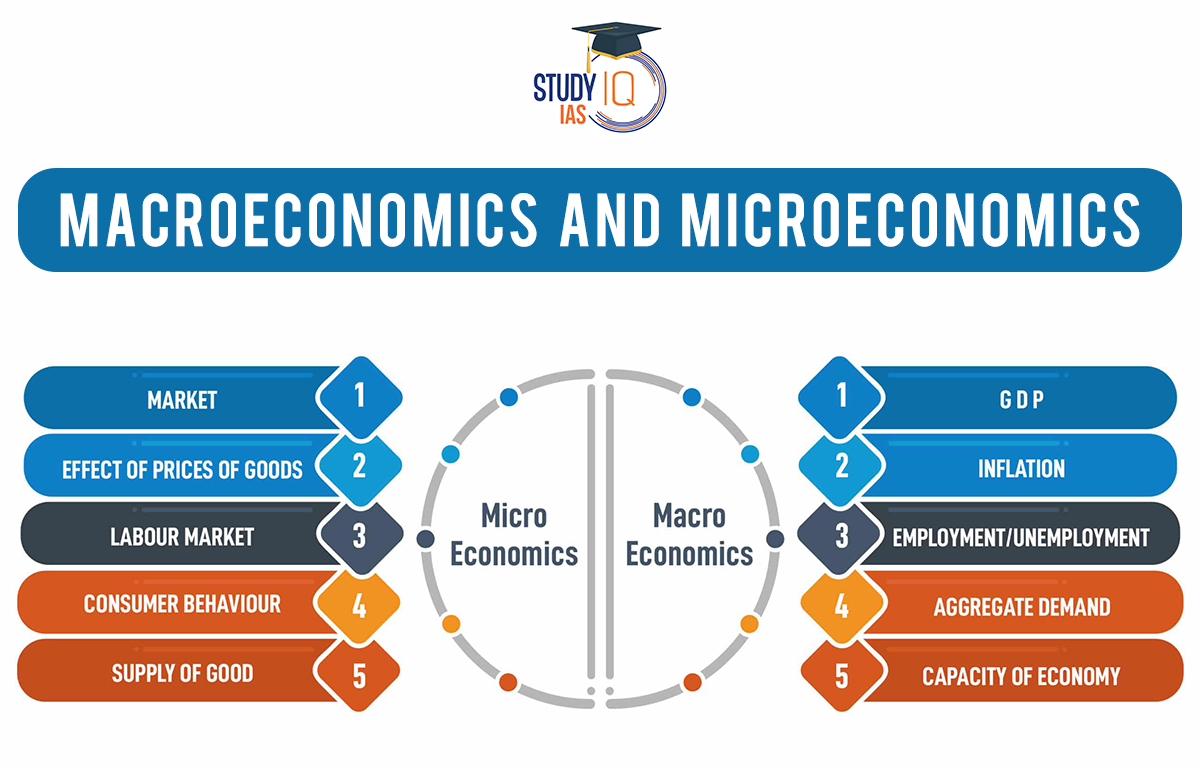Table of Contents
Macroeconomics and Microeconomics
Economics is the social science that studies how individuals, businesses, governments, and societies make choices about how to allocate resources to satisfy their needs and want. Economics is concerned with analyzing how people make decisions, how markets operate, and how economies grow and develop over time. The study of economics is typically divided into two main branches: Macroeconomics and Microeconomics.
Both Macroeconomics and Microeconomics are important for understanding how the economy functions and for making informed decisions about economic policy. While microeconomics provides insights into how individual agents make decisions and how markets work, macroeconomics allows us to understand the broader trends and patterns in the economy as a whole.
Read about: List of RBI Governors of India
Difference Between Macroeconomics and Microeconomics
Understanding both Macroeconomics and Microeconomics principles is important for gaining a comprehensive understanding of the economy and making informed economic decisions. Here is a comparative analysis of the two terms for our better understanding.
| Macroeconomics | Microeconomics |
| Deals with the economy as a whole | Deals with individual units within the economy |
| Focuses on aggregate economic variables like GDP, inflation, unemployment, and interest rates | Focuses on specific economic units such as households, firms, and industries |
| Analyzes the behaviour of large-scale economic systems | Analyzes the behaviour of small-scale economic systems |
| Examines the economy at a national and international level | Examines the economy at a local and regional level |
| Concerned with government policies that impact the economy | Concerned with how individual economic agents make decisions and how markets operate |
| Studies the interactions between different sectors of the economy, such as the financial sector, the labour market, and the international trade sector | Studies how prices, supply and demand, and market structures impact the decisions of individual economic agents |
| Examples of topics studied include inflation, economic growth, fiscal and monetary policy, and international trade | Examples of topics studied include consumer behaviour, production costs, market competition, and labour economics |
Read about: Unemployment Rate in India
Scope of Macroeconomics
The scope of macroeconomics is quite broad and covers a wide range of topics related to the functioning of national and international economies. The scope of macroeconomics includes the following:
- National Income and Output: Macroeconomics studies the measurement and analysis of national income and output, including Gross Domestic Product (GDP), Gross National Product (GNP), and other aggregate measures of economic activity.
- Unemployment: Macroeconomics examines the causes and consequences of unemployment, as well as the policies that can be used to reduce unemployment rates.
- Inflation: Macroeconomics studies the causes and effects of inflation, as well as the policies that can be used to control inflation rates.
- Economic Growth: Macroeconomics examines the factors that contribute to long-term economic growth, including technological progress, investment, and human capital development.
- Monetary Policy: Macroeconomics analyzes the role of central banks in controlling the money supply and managing interest rates to achieve macroeconomic goals such as price stability and full employment.
- Fiscal Policy: Macroeconomics studies the use of government spending and taxation policies to influence economic activity and achieve macroeconomic objectives.
- International Trade and Finance: Macroeconomics examines the interaction of national economies in international trade and finance, including exchange rates, the balance of payments, and international capital flows.
- Economic Development: Macroeconomics studies the economic development of countries, particularly those that are less developed, and the policies that can be used to promote growth and development.
Read about: Index Ranking of India 2022
Limitations of Macroeconomics
Macroeconomics has its limitations, and it is important to be aware of these limitations when analyzing economic data and making policy decisions. Some of the limitations of macroeconomics are:
- Aggregate Analysis may not Capture Individual Behaviour: Macroeconomics focuses on analyzing the economy as a whole, which may not accurately reflect the behaviour of individual economic agents such as households and firms.
- Data Limitations: Macroeconomics relies heavily on data, which may not always be accurate or complete. This can lead to inaccurate analysis and policy prescriptions.
- Simplified Assumptions: Macroeconomic models often make simplified assumptions about the behaviour of economic agents, which may not always reflect reality. For example, assumptions about rationality or perfect information may not hold in real-world situations.
- Difficulty in Predicting the Future: Macroeconomic analysis often involves making predictions about future economic conditions. However, it can be difficult to accurately predict future events and economic conditions due to the complexity of economic systems and the influence of external factors.
- Political Factors: Macroeconomic policies are often influenced by political considerations, which can result in policies that may not be optimal from an economic standpoint.
- International Factors: Macroeconomic analysis often overlooks international factors that can have a significant impact on national economies. For example, changes in global economic conditions or policies can have spillover effects on national economies.
Read about: Finance Ministers of India List
Basic Macroeconomic Concepts
Some of the basic macroeconomic concepts include:
| Concept | Definition |
| Gross Domestic Product (GDP) | Typically calculated over a year, the total value of goods and services produced within the borders of a country is measured |
| Inflation | The increase in the general level of prices for goods and services over time is referred to as inflation rate |
| Unemployment | The number of people who are capable and available to work, but are unable to secure employment, is known as unemployment |
| Monetary policy | The actions of a central bank to manage the money supply and interest rates in order to achieve macroeconomic goals such as price stability and full employment |
| Fiscal policy | The use of government spending and taxation to influence the level of economic activity and achieve macroeconomic objectives such as full employment and price stability |
| Trade balance | The discrepancy between the value of goods and services that a country exports and the value of those that it imports is known as the balance of trade |
| National Debt | The outstanding sum of money that a government owes to its creditors, which is frequently represented as a percentage of GDP, serves as an indicator of a country’s financial well-being. This is known as the government debt |
| Gross National Product (GNP) | A measure of the total value of goods and services produced by a country’s citizens, regardless of their location, over a specified period, typically a year |
| Balance of Payments (BoP) | A record of all economic transactions between a country and the rest of the world over a specified period, including trade in goods and services, income flows, and capital flows |
| Exchange Rate | The value of one currency in terms of another currency, often expressed as the amount of one currency required to purchase one unit of the other currency |
| Interest Rate | The cost of borrowing money, typically expressed as a percentage of the amount borrowed, or the return earned on saving or investing money |
| Aggregate Demand (AD) | The total demand for goods and services in an economy at a given price level, including consumption, investment, government spending, and net exports |
| Aggregate Supply (AS) | The total amount of goods and services that producers are willing and able to supply at a given price level |
| Economic Growth | An increase in the production of goods and services over time, often measured by changes in GDP or GNP |
| Business cycle | The recurring pattern of expansion and contraction in economic activity, typically measured by changes in GDP over time |
| Phillips curve | A graphical representation of the inverse relationship between unemployment and inflation, which suggests that when unemployment is low, inflation is high and vice versa |
| Crowding Out | A phenomenon whereby increased government spending or borrowing leads to a reduction in private investment, as resources are diverted away from the private sector |
| Trickle-down Economics | A theory that suggests that economic benefits generated by the wealthy and businesses will eventually trickle down to benefit the rest of society |
| Keynesian Economics | A macroeconomic theory that emphasizes the role of government intervention in managing the economy, particularly through fiscal policy, to achieve full employment and stable prices |
Read about: Minimum Support Price
Macroeconomics and Microeconomics UPSC
Macroeconomics and Microeconomics are important topics for UPSC as they form an integral part of the Economics paper in the UPSC Syllabus. The UPSC Exam assesses candidates’ knowledge and understanding of these concepts, and their application in real-world scenarios.
Aspirants who are preparing for UPSC exams can benefit greatly from studying Macroeconomics and Microeconomics, as they provide a framework for analyzing the behaviour of the economy at both a micro and macro level. Understanding these concepts is essential for understanding government policies, international trade, economic growth, and other key topics in the UPSC Syllabus.
To prepare for this topic, candidates can refer to StudyIQ UPSC Online Coaching, which provides comprehensive and in-depth coverage of macroeconomic and microeconomic concepts, along with practical examples and case studies. Additionally, they can take UPSC Mock Test to assess their knowledge and track their progress, and identify areas that require more attention.


 Repo Rate and Reverse Repo Rate, Impact ...
Repo Rate and Reverse Repo Rate, Impact ...
 Foreign Contribution Regulation Act (FCR...
Foreign Contribution Regulation Act (FCR...
 Urban Cooperative Banks in India, Functi...
Urban Cooperative Banks in India, Functi...





















